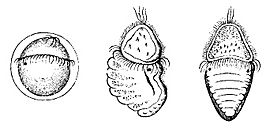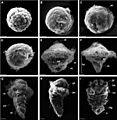Trochophore facts for kids

A trochophore is a special type of larva (a young form of an animal) that lives in the ocean. These tiny creatures float around as part of the plankton, which is a collection of small plants and animals in the water. You can find trochophore larvae in several different groups of invertebrate animals, especially those belonging to a larger group called Lophotrochozoa.
Trochophores have tiny hair-like structures called cilia. They usually have two or more bands of these cilia. By moving their cilia very quickly, they create swirling water currents. This helps them move where they want to go. It also helps them bring food closer, making it easier to catch and eat.
Contents
What is a Trochophore?
A trochophore larva is very small, often just a fraction of a millimeter long. It is a temporary stage in the life cycle of many marine animals. These animals include some types of molluscs (like snails and clams), annelid worms (like segmented worms), and other related groups.
The trochophore stage is important for these animals. It allows them to spread out to new areas. Since they float in the water, ocean currents can carry them far from where their parents lived. This helps the species survive and find new places to live.
How They Move and Eat
The most noticeable feature of a trochophore is its bands of cilia. These cilia are like tiny oars that beat in a coordinated way. The main band of cilia, called the prototroch, is used for swimming. It creates a current that pushes the larva through the water.
Other bands of cilia help with feeding. They create currents that sweep tiny food particles, like algae and bacteria, towards the trochophore's mouth. This way, the larva can get the energy it needs to grow and develop into its next stage.
Life Cycle and Development
The trochophore larva is usually a short-lived stage. After a period of swimming and feeding, the trochophore goes through a big change called metamorphosis. During metamorphosis, the larva transforms into a juvenile (young) form of the adult animal.
For example, a trochophore of a snail will change into a tiny snail. A trochophore of a marine worm will change into a small worm. This transformation can involve many changes in body shape and internal organs. The juvenile animal then settles down and grows into an adult.
Images for kids
See also
 In Spanish: Trocófora para niños
In Spanish: Trocófora para niños



